A day in the life of a potbellied pig caregiver
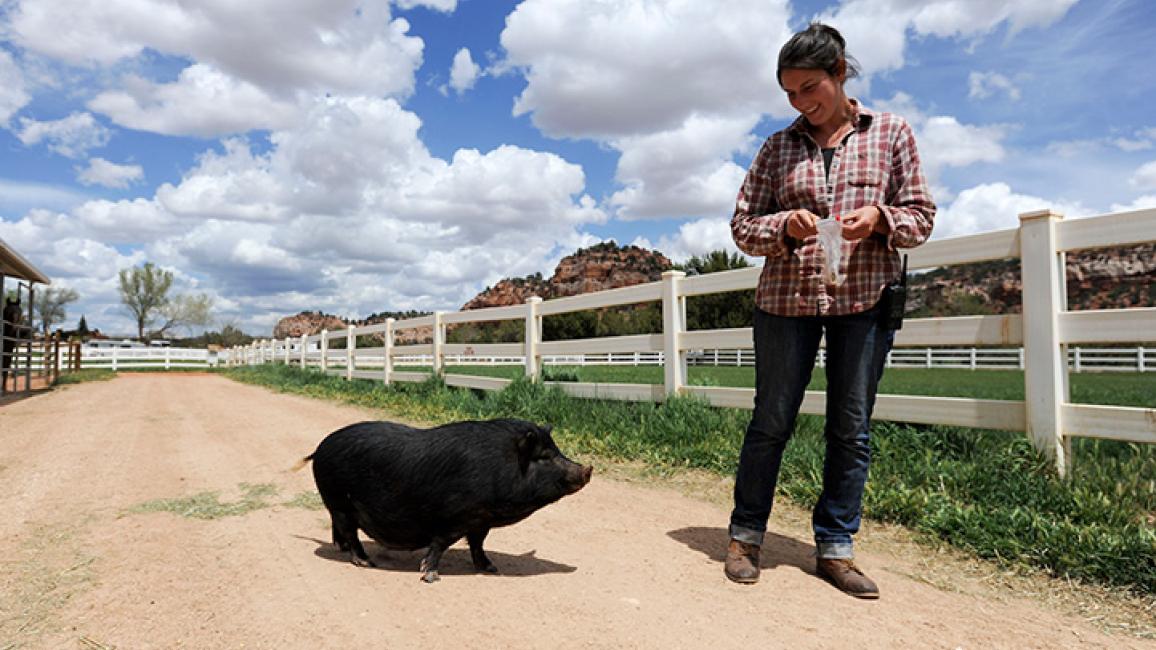
Nestled in the sprawling red rocks of southern Utah, Best Friends Animal Sanctuary is more than a refuge for homeless pets. It’s a place where transformations happen every day.
No matter where animals came from, what happened in their pasts or what challenges they face, from the moment they arrive at the Sanctuary they receive all the medical care, TLC and training they need to help them feel comfortable and happy in their home between homes.
Rosalie Wind, a caregiver at Marshall’s Piggy Paradise and Horse Haven, works primarily with potbellied pigs and potbellied pig mixes. In the following interview, she shares what it’s like to work and bond with these intelligent and sensitive animals.
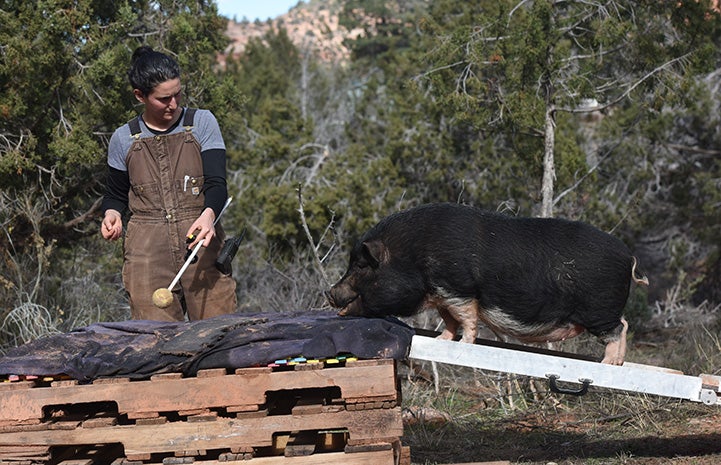
The pigs at Marshall’s Piggy Paradise have come to Best Friends for many different reasons. Every pig is an individual and every pig has a different story. An important part of the work we do is educating the public and addressing myths about pig breeds, behavior and welfare.
Just like dogs and cats, pigs love attention, play, training and affection. They wag their tails and get "zoomies" when they’re happy. They love belly rubs and going for walks. And just like dogs and cats, pigs love their families and their hearts can break when they can no longer stay in their homes.
Myths about teacup pigs
The most common reason pigs can’t stay in their homes is size. People often buy “teacup” pigs from a breeder and believe they will increase in size anywhere from five to 50 pounds. But this is a myth. Teacup pigs (sometimes called toy pigs, miniature teacup pigs, mini teacup pigs, micro mini piglets or nano pigs) are potbellied pigs.
Originally bred in Vietnam, the potbellied pig is a domestic pig that is indeed miniature when compared to the average farm pig. Adult farm pigs can weigh in at around 1,000 pounds, and most potbellied pigs end up somewhere between 100 and 200 pounds. Trying to keep pigs smaller than this can have an extremely negative effect on their health and well-being.
People also surrender pigs to Best Friends for behavior issues. We hear things like, “I have a teacup pig and she’s bossy,” or “I have a teacup pig and she’s destroying the kitchen.” Behavior issues are most common if pigs don’t live with other pigs or if they live indoors. Pigs are social animals who enjoy spending their days outside with other pigs — snouts in the dirt, keeping busy. At the Sanctuary, we do clicker training, natural horsemanship (which isn’t just for horses, but also works well with pigs and goats) and different types of enrichment to keep our pigs active and healthy.
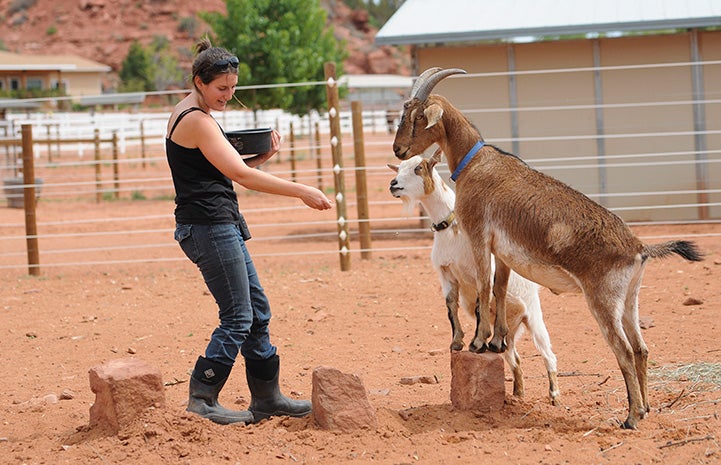
Making friends with Cutie the pig
I'm often asked if I have a favorite pig. Like most caregivers, I love them all, but I do have favorites. There is one who is special to me — a pig who taught me that the little things in life are just as important as the big ones.
Cutie came to Best Friends in 2014 after her family couldn’t keep her anymore. My first encounter with Cutie wasn’t meeting her, but hearing her. During a staff meeting, our team lead pulled up outside to unload Cutie. It's not uncommon for pigs to be opinionated, especially when you're asking them to do something they don't want to do. During our meeting, all we could hear was the screaming and squealing going on outside, as Cutie protested getting out of the trailer and into her new enclosure.
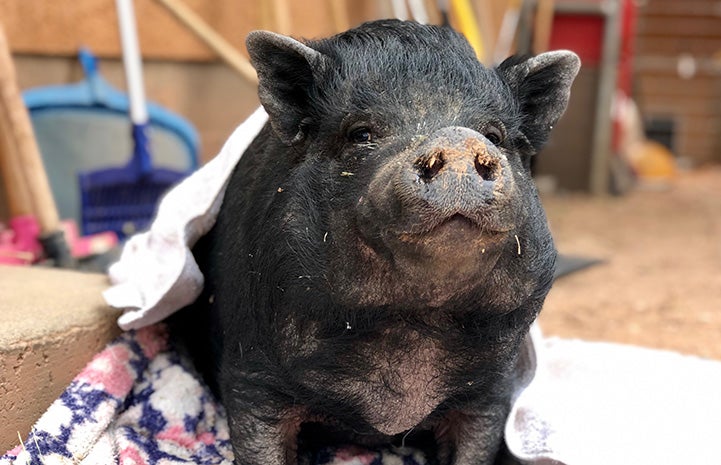
When I finally met her in person, things went about the same. She was chomping and posturing (a sign of nervousness or anxiety), and I stood my ground. The best response for chomping depends on the pig’s reason for chomping. A sensitive and emotional pig does best if you ignore the behavior; but with a more confident, thoughtful pig, it may be better if you respond.
With Cutie, I held a red board out in front of me. The board acts as a boundary and a protective barrier between us. Until we get to know a pig’s intentions, we can’t be sure if they’re just posturing or if they are scared. Meanwhile, we have to get close to feed, clean, etc., and we want everyone to stay safe.
The boundary board showed Cutie that she couldn’t push into my space. We use boards to show pigs not only where not to be, but also where they should be. For example, you can use one to help a pig enter a crate or trailer. It’s similar to the carrot stick tool we use with horses, because it’s an extension of your body, and it can make the crate or trailer the most comfortable option.
As soon as Cutie respected the boundary, I took it away. I recommend using a board with pigs who lunge at people, because you feel much safer when you have it front of you. When you feel safer and more comfortable, pigs can feel that energy and they will feel more comfortable too. When I took the board away, Cutie immediately relaxed and asked for a belly rub. Putting herself in this vulnerable position so soon showed me she wanted attention. She was just new and scared.
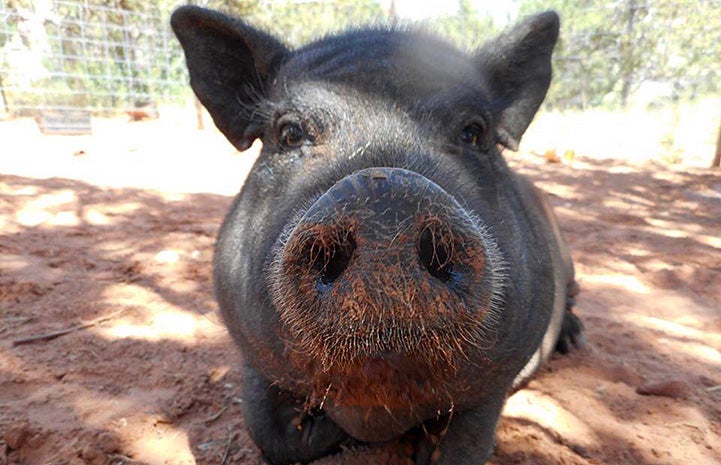
Pig spirit overcomes special needs
Cutie’s severe arthritis and joint issues come from breeding and an inappropriate diet. She doesn’t know she has special needs, and she’s used to getting around on her tiny and sometimes painful body. Luckily, she’s tolerant of medical handling so she can benefit from different pain treatments: laser therapy, electric heat therapy, monthly Adequan injections and even acupuncture. She puts up with all of it, even when she’s opinionated on the matter.
I’m in awe of Cutie’s spirit. She came here at five years old with special needs. She hadn’t lived with other pigs since she was a baby, and here at Best Friends she’s met all kinds of new pigs and had to deal with her medical treatments and southern Utah’s cold winters and hot summers. Still, through all of this, she's often seen lying happily on her soft heating pad, grumbling at a next-door neighbor or soaking up the sun.
Ever since the day I first heard Cutie, she’s been my favorite pig — not only because she trusted me so soon after meeting me, but her acceptance of the body she was given showed me that even when life gives you adversity, you have a choice. From birth, Cutie got the short end of the stick, but every day she chooses to overcome her issues. She’ll be 10 this year, and since pigs live on average about 15 to 18 years, I know she won’t live forever. But every day I make it a point to cherish our time together, whether we’re doing clicker training or just hanging out in the sun together.
Save lives. Join Best Friends.
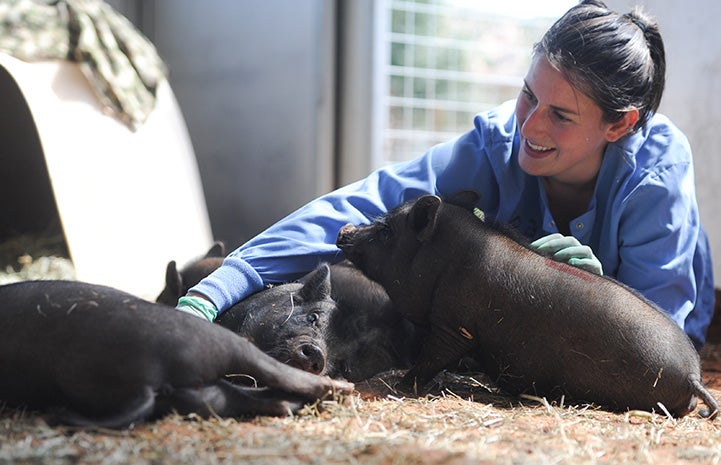
Photos by Molly Wald and Rosalie Wind